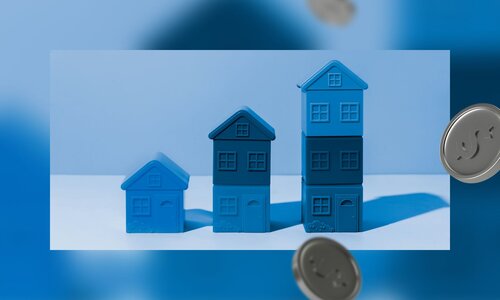Before you take out a loan to finance your investment property, it’s important to know how the loan repayment process works. Amortization is a key piece of that process for most types of loans.
Key takeaways:
- Amortization is an accounting technique that lowers the value of a loan over a set period of time.
- The amortization schedule depends on the type of loan or mortgage you have on your home or rental property.
- There are three common types of amortization schedules: fully amortized, negative amortization, and positive amortization.
- Amortization differs from depreciation, but both are essential concepts for real estate investors to understand.
What is Amortization?
Investopedia defines amortization as “an accounting technique used to periodically lower the book value of a loan or an intangible asset over a set period of time.”
In simple terms, it’s the process of front-loading loan payments so that earlier payments go toward paying off interest early, so the loan payment decreases over time.
The most straightforward example of amortization in real estate is in loans with private mortgage insurance (PMI). Private mortgage insurance is a type of mortgage insurance that most lenders require when you make a down payment of less than 20%. In this scenario, the amortization schedule has larger payments upfront until the borrower reaches the 20% down payment amount and no longer needs PMI.
Here’s how it works.
Let’s say you purchase a home for $250,000 but can only put down 10% or $25,000. As a result, your lender requires PMI. Your mortgage payments will be higher until you meet the required $50,000 down payment amount. After then, your monthly loan payment will decrease.
10 amortization terms to know
- Amortization schedule. An amortization schedule shows how the term of your loan progresses. When you review it, you’ll be able to see how a larger share of your payment goes toward paying down the loan principal until the loan amount is paid in full at the end of your term.
- Intangible asset. An intangible asset is an asset with no physical form, such as intellectual property. It’s a long-term asset that accrues value year over year.
- Interest rate. An interest rate is the amount a lender charges a borrower for the loan and is calculated as a percentage of the principal balance. Interest rates on loans are usually noted on an annual basis known as the annual percentage rate (APR).
- Interest payments. Interest payments are the payments a borrower makes in addition to paying back the principal on a loan. They’re paid on a regular schedule, typically monthly, and at an annual interest rate established when the loan is initiated.
- Loan balance. This is the amount of debt owed at the beginning of the loan period. If you’re just starting your loan, this can be the loan’s original amount. If you’re already making payments, this is the amount carried over from the prior month.
- Loan term. A loan term is the period of time, or duration, until the loan is paid off. This is typically 60 months, or five years, for an auto loan and a 30-year mortgage.
- Principal balance or principal amount. This is the amount a lender loans a borrower. It’s what the borrower must pay back, plus any interest payments.
- Principal payments. A principal payment is simply a payment made toward the original amount of a loan that is owed – the principal balance. Principal payments can be either partial amounts of the amount due or the full amount of the loan.
- Tangible asset. A tangible asset is an asset that has a physical form. There are two types of tangible assets: inventory and fixed assets. Inventory is the assets produced by a company, including raw materials. Fixed assets are tangible assets the company holds to produce goods or provide services, like rental property, machinery, or vehicle.
- Useful life. An asset’s useful life is an estimate of the average period, usually in years, an asset is considered useable before its value is fully depreciated.
3 types of amortization schedules
Lenders use different amortization methods to create a loan’s amortization or payment schedule. Below is an overview of the three most common types of amortization schedules.
Fully Amortized Loans
A fully amortized loan is where the borrower makes payments according to the original amortization schedule of the loan. As a result, the loan is paid in full at the end of the loan term.
Negative Amortization
With negative amortization, the borrower makes the required minimum payments, but the amount owed continuously increases because the minimum doesn’t cover the cost of interest. As a result, the borrower’s debt increases with each payment.
Positive Amortization
With positive amortization, lenders require borrowers to repay part of the principal balance with each loan payment. As a result, the loan balance decreases with each payment.
How does amortization work in real estate?
The answer to this question depends on the type of loan a homeowner or investor has on the property. Here’s a breakdown of the most common types of loans.
Fixed-Rate Mortgage
A fixed-rate mortgage has a fixed interest rate throughout the life of the loan and predictable monthly payment. At the beginning of a fixed-rate mortgage, a higher portion of the monthly payment is applied to the interest. Over time, that changes, and more of the monthly payment is applied to the principal as the interest balance decreases.
Adjustable-Rate Mortgages (ARMs)
An adjustable-rate mortgage (ARM) is a home loan where the interest rate adjusts over time depending on market conditions. Most ARMs have an introductory period where the borrower pays a fixed interest rate. After the introductory period is over, the lender adjusts the interest rate to reflect market conditions. It may increase or decrease.
Interest-Only Mortgage
An interest-only mortgage is one where you only pay interest the first several years of the loan, usually an introductory 10 years for a 30-year mortgage. It makes your initial monthly payments lower, but they significantly increase after the introductory period when you make principal and interest payments for the remaining loan term.
Balloon Mortgage
A balloon mortgage is a home loan with a large, one-time payment due at the end of the mortgage term. Balloon mortgages can be structured in many ways. Some may start with interest-only payments, and others may require principal and interest monthly payments. However, in every balloon mortgage, the borrower will be required to pay a lump sum payment at the term of the loan.
How to calculate amortization
Bankrate has a great amortization calculator. Use it to get an idea of how amortization will affect your mortgage payments and a sample amortization table.
Amortization vs. Depreciation
As mentioned earlier, amortization is the accounting practice of spreading the cost of a loan or an intangible asset over its useful life. It’s a way to pay off the debt in equal installments that include varying amounts of interest and principal payments over the life of the loan.
Depreciation is “an accounting method used to allocate the cost of a tangible or physical asset over its useful life,” according to Investopedia. It refers to the expensing of a fixed asset over its useful life. In real estate, depreciation is used to deduct the costs of buying and improving a rental property.
Closing thoughts
Amortization is an important concept to understand because, ultimately, it’ll help you determine the type of mortgage that works best for you. Use the information above to talk with your real estate agent and financial advisor.
Easily invest in rental properties today
Let us help. Arrived lets you buy shares of rental properties, including vacation rentals, without dealing with mortgages. We also handle all the property management, so you get the benefits of being a real estate investor without the hassle. Browse our available properties to start investing in real estate today.
The opinions expressed in this article are for general informational purposes only and are not intended to provide specific advice or recommendations for any individual or on any specific security or investment product. The views reflected in the commentary are subject to change at any time without notice. View Arrived’s disclaimers.







